27 November 2023
Rocking our late Queen’s passion for horses
8 minutes
Nobody embraced horsemanship better than our late Queen Elizabeth II – she was an accomplished rider, owner and breeder – and we all fondly remember her enthusiasm when cheering on winners at Royal Ascot and the Epsom Derby.
She had a lifelong respect for horses and knew, as playwright and poet Ben Johnson (1572-1637) expressed so well: ‘Princes learn no art truly, but the art of horsemanship. The reason is, the brave beast is no flatterer. He will throw a prince as soon as his groom’.
Her Majesty’s love of horses began by riding a dapple grey rocking horse in the royal nursery, learning to mount and balance before her grandfather King George V gave her a Shetland pony called Peggy.
The Queen learned to ride at an early age and built her horsemanship through watching horses in training with her father King George VI.
A soft spot for rocking horses also continued throughout the Queen’s life as I learned from a visit to rocking horse makers Stevenson Brothers, in Kent, on the first anniversary of the Queen’s passing.
Co-directors Marc and Tony Stevenson had presented the Queen with six bespoke rocking horses, over 20 years, to mark special occasions during her reign.
On the wall of the twin brothers’ head office in Bethersden, I found myself admiring a 1932 photograph of Her Majesty, as a child, riding a rocking horse with sister Princess Margaret.
“Rocking horses have been a regular fixture in royal nurseries for centuries,” Marc explained. “The purpose of a rocking horse is to teach a person to ride. Back in the day when the only way to get around was to walk or ride a horse it made sense to introduce riding at an early age.”
Marc and Tony launched their business in 1982 and pride themselves on producing handmade rocking horses that are ‘fit for royalty’.
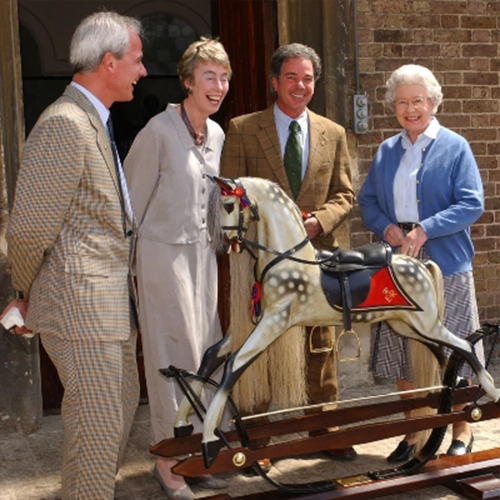 |
The first rocking horse the brothers presented to Her Majesty was to commemorate the 2002 Golden Jubilee. Marc said: “It was the Queen’s 50th anniversary as monarch, our company’s 20th year and our 5,000th horse. “In the 1932 picture, the Queen and Princess Margaret are sitting on an F H Ayres rocking horse in their nursery. It was the King George VI’s rocking horse so we kept to tradition when hand-crafting a dapple grey for the Queen, mounted on a coach spring, which gives a wonderful ride and enables the rider to extend the horses stride. We also added a side saddle pommel. “Her Majesty was thrilled when we presented it to her at Windsor Castle and from then we marked her Diamond and Platinum Jubilees and 80th and 90th birthdays with a rocking horse. “For her 80th birthday in 2005, we built Tinkerbell, the Queen’s favourite skewbald horse, while for her 90th we introduced Burmese, a handsome black oak rocking horse based on the real Hanoverian horse, St John, gifted to the Queen by the Royal Canadian Mounted Police. It features a secret bottom drawer inlaid with a maple leaf and a leaf-shaped bottle of maple syrup which appealed to her majesty’s humour. (Image: The Golden Jubilee rocking horse presentation to Her Majesty the Queen from Tony Stevenson, left, Sue Russell and Marc Stevenson.) |
“We also presented the Magna Carta horse to commemorate the 800th Anniversary of King John sealing the Magna Carta at Runnymede – when the King rode from Windsor Castle to Runnymede on a white charger. We made a replica of that horse and put a miniature handwritten copy of the Magna Carta on parchment in a secret chest drawer.
“To mark the Diamond Jubilee, we wanted to honour the lifelong friendship between the Queen and her former Prime Minister Sir Winston Churchill. He served with the 4th Hussars in the 1915 Abyssinia campaign so a replica of his horse, Charger, featured a military saddle and tack complete with bedroll. The Shabraq (saddlecloth) was beautifully hand embroidered with the regimental crest and edged in gold. At the rear of the horse we added a secret compartment containing photographs of the Queen and Sir Winston wrapped in a leather pouch. She was absolutely thrilled.
“The last time I saw Her Majesty was in July 2022, after the Windsor Horse Show, when our team presented her with a Platinum Jubilee rocking horse, based on Barbershop, the last racehorse bred by the late Queen Mother. That day will always be incredibly special to us.”
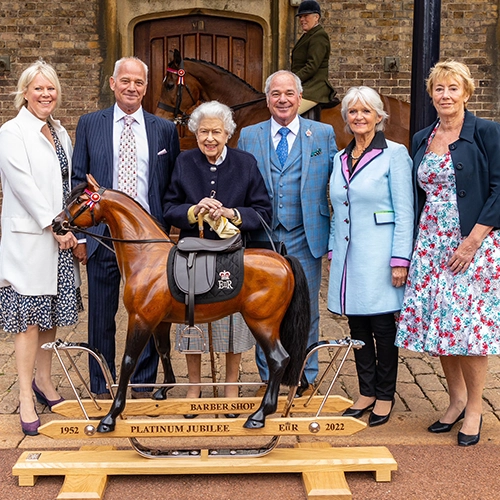
(Image: The Golden Jubilee rocking horse presentation to Her Majesty the Queen from Tony Stevenson, left, Sue Russell and Marc Stevenson.)
Toys or investments
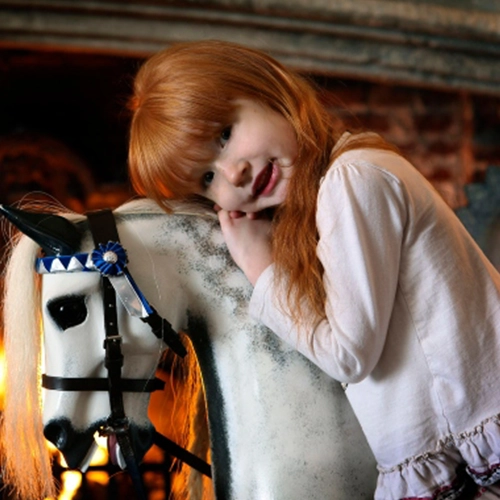 |
On my tour of the showroom and orderly workshop the smell of wood, leather, paint and varnish added an evocative air to the building where skilled craftsmen work on made-to-order rocking horses. I ask Marc whether these exquisite rocking horses are toys, designer statements or investment pieces. Marc’s view is that they are ‘heirlooms – the enduring symbol of childhood that can be passed down through the generations’. He said: “Our rocking horses do lend a wonderful ambience to a room, especially in a hall when it is the first thing visitors see. They are certainly heirlooms so we add a date and number while personalising the horse as much as we can – if a buyer has a family crest we will embroider it on the saddlecloth. The name plate can include a message and the recipient’s name and date of birth. It is rare for families to part with their rocking horses. “Many models are inspired by real-life, much-loved horses. They include Valegro the dancing horse. When Charlotte dujardin CBE retired Allegro at Olympia she came ‘backstage’ afterwards and we presented her with a Valegro rocking horse commissioned by her husband Dean Golding. Charlotte had won Gold at the London and Rio Olympics – so for the most successful British dressage rider in the history this memento was so special. We all cried that night.” (Image: A much-loved rocking horse usually becomes a family heirloom.) |
While Marc is reticent to name his buyers, I can’t help noticing photos on the walls of celebrities with their special rocking horses – Bruce Springsteen, Paul McCartney and former West Ham goalkeeper Shaka Hislop to name a few, so I have to ask whether King Charles III can expect ‘a gift’ as Stevenson Brothers’ Coronation exhibition ‘All the King’s Horses’ went down a storm at Tenterden Town Hall.
Marc smiles and pats a newly hand-carved wooden horse that is under a protective cover in the workshop … so place your bets for an odds-on favourite!
How it started for the Stevensons
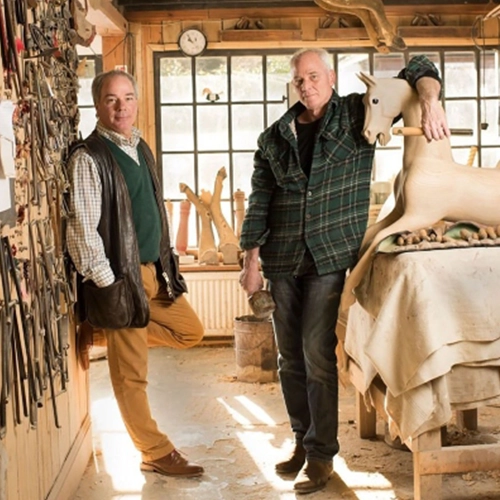 |
Marc and Tony always thought they would run a business together. The twins are close, spending their early years as ‘wild boys growing up in Kenya’ while their father and uncle James worked in the Kenya Prison Service. The boys returned to England for their education and later Marc attended Bristol Academy of Art & Design and went into graphic design while Tony, a sculptor, worked at Orlestone Mill, in Kingsnorth, making oak pit props for Kent coal mines. With mines closing and the design business established, the twins made a plan to combine their skills and asked their Uncle James, a former Chatham Dockyard shipwright, to teach them his retirement hobby of making rocking horses. Marc said: “Uncle James was a curmudgeonly chap and refused our request. He said ‘No, go and get proper jobs. Nobody wants rocking horses these days. “We didn’t give up and during our next visit he said: ‘Pay me £1,000 and I will give one of you five weeks’ training’. We had to borrow the money so Tony did the training and then taught me. That was in 1982 and our rocking horses began to evolve through tweaking Uncle Jack’s templates, such as turning the horses’ heads to the left as riders learn to mount from that side and using lime wood, not pine. (Image: Marc and Tony in the workshop at Bethersden, Kent.) |
“Tony being the more practical one expanded the workshop while I got on with the sales and marketing, going to shows including Badminton, Burghley, The Game Show and RHS Chelsea. We then found Sue Russell, a neighbour, to run the admin and book-keeping side and 40 years on she remains a lynchpin of our 12-strong family business.”
The next chapter
The Stevenson Brothers’ building is a traditional white weatherboarded property on the main road connecting Ashford and Tenterden. A rocking unicorn adorns the roof and generations have now come to love looking out for the horse, which has changed a few times, including a Zebra that was blown off in a storm.
“We get phone calls saying that children are upset if ever a horse is missing from the roof,” says Marc. “But actually we need more space to exhibit our new and historic rocking horses, including limited editions of the Queen’s special six, best-selling steel grey and dapple greys, one-offs such as punk Vivienne Westwood horse and many other collectibles.
“Plans have now gone to Ashford Borough Council to build an eco-friendly museum, showroom, café and workshop in nearby High Halden, to make Stevenson Brothers a splendid, unique destination for visitors.
“Tony and I are 66 this year so can draw our pension but we will continue to make 120 rocking horses a year. It seems to work out 10 a month as we intentionally work slowly to ensure the very best quality. Instead of dashing around the country it will be lovely to invite customers here to the Garden of England where they can immerse themselves in our unique world of rocking horses.
“To finance the project we hope to build some houses on nearby land and will replace our existing building with nine apartments in the same weather-boarded style, complete with a horse on the roof.
“We are very involved in our community so want to get this right. In fact, we have made a rocking horse to raise funds for St Margaret’s, our local church, which needs to raise £150,000 to replace the ancient oak belfry.”
Visit stevensonbros.com
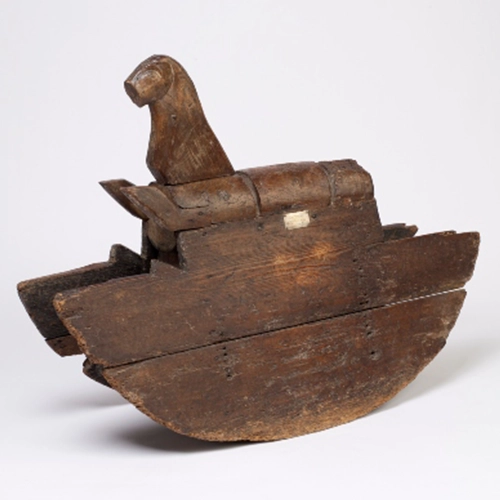 |
It is thought that rocking horses have been around since the 1600s and the Victoria & Albert Museum in London has a 17th-century rocking horse that is traditionally associated with the childhood of Charles I, one of Britain's most equestrian kings. If this rocking horse were his, it would probably date from 1605-08. However, there is no solid contemporary record of this half-moon shaped rocking horse which has boarded sides, a log body between the two rockers and a very naive head. It is believed it may have derived from the rocking cradle. Charles, the second son of James VI was a delicate child and still unable to walk when his father created him Duke of York in 1605. His remedial treatment is understood to have been a rocking horse to exercise and strengthen his legs and by 1610 he had made great progress and could walk, ride, play tennis and dance. If the V&A’s rocking horse had a plaque attached to it which reads “Purchased on June 18th 1906 at Cheshunt House Hertfordshire”. This was close to Theobalds Palace, a favourite residence of James I that was demolished in the 18th century. We can probably never prove or disprove the rocking horse’s royal association but its significance lies more in its early date and rarity. By the 1800s, rocking horses had become a popular toy and in Victorian times it is understood Prince Albert introduced rocking horses to the royal household as part of his Christmas tradition. Queen Victoria also visited rocking horse maker J. Collinson and Sons of Liverpool, arriving on a dapple grey horse, and so the company became well-known for its dapple grey rocking horses. (Image: The V&A Museum has one of the earliest rocking horses in its collection. Credit vam.ac.uk.) |
Insurance advice
A valuable family heirloom should be insured under the Art and Antiques section of your home insurance policy. Ensure there is a good description with distinguishing features, size and images which will help with identification. Consider the cost of replacement if damaged.
Valuations for insurance are normally based upon a retail replacement value, i.e., what it would cost the owner in the retail market. So, think about where you would replace the item – a top-end antique shop or auction – and by doing this at the outset you are avoiding disputes and queries at a later date, or in the event of a claim.
Find out more about Howden Collectibles Insurance.
To speak to Howden about insuring your family heirlooms, call 020 8256 4901 or email privateclients@howdeninsurance.co.uk
